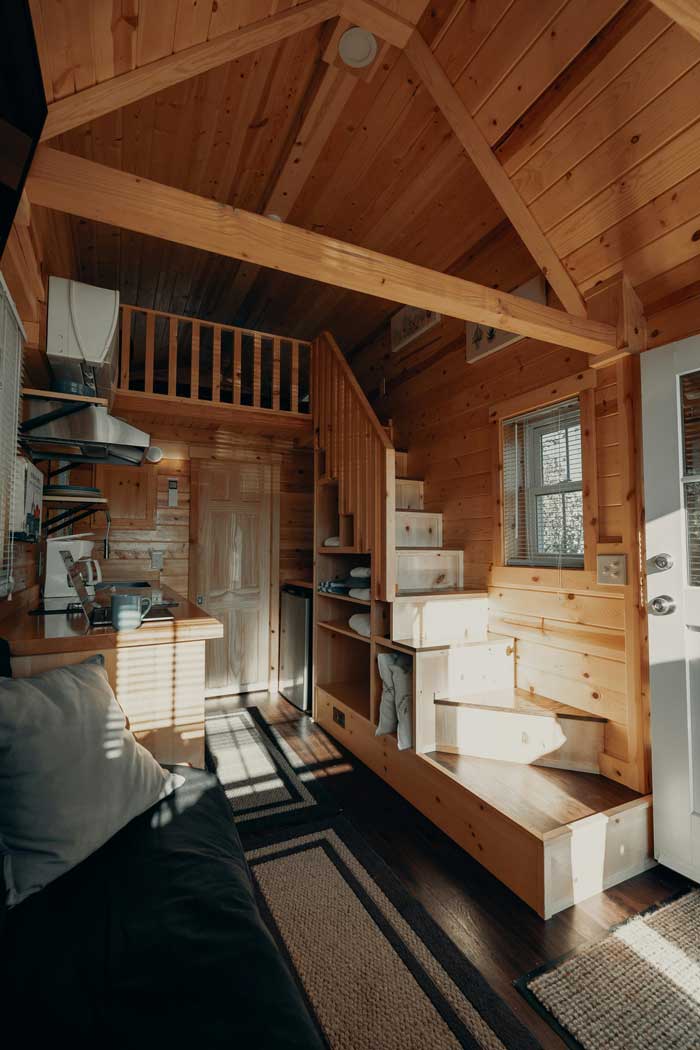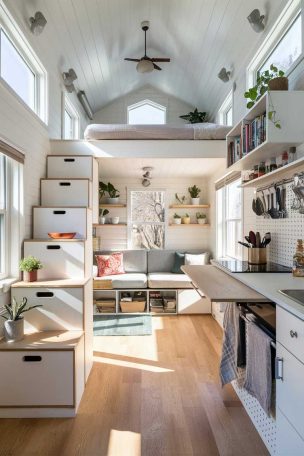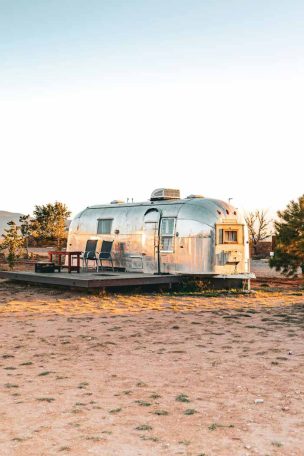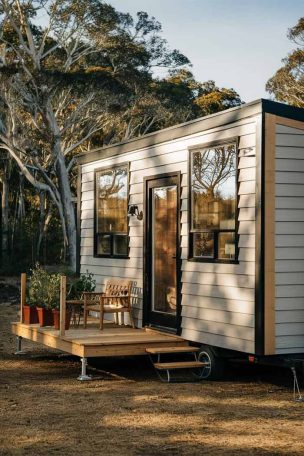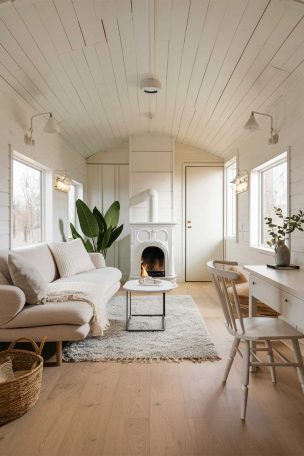In recent years, the tiny house movement has gained significant traction, captivating the imagination of those seeking an alternative to traditional homeownership.
But what’s driving this trend, and is it right for you?
Let’s dive into the compelling reasons why more and more people are choosing to downsize their living spaces and upsize their lives.
1. Financial Benefits
When it comes to housing, money talks.
And tiny houses?
Well, they’re practically shouting savings from the rooftops.
Reduced Initial Costs
Let’s start with the elephant in the room – or should I say, the elephant that’s not in the tiny room.
The cost difference between a tiny house and a traditional home is staggering.
While the average single-family home in the US will set you back around $300,000, you can snag a tiny house for a fraction of that.
We’re talking $30,000 to $60,000 on average.
That’s like paying for a luxury car but getting a home instead!
Lower Monthly Expenses
But the savings don’t stop at the purchase price. Living in a tiny house is like putting your monthly expenses on a diet.
Your utility bills? They’ll shrink faster than your living space did.
Property taxes? They’ll be so low you might forget they exist.
And maintenance costs?
Well, there’s less to maintain!
Long-Term Financial Advantages
Now, here’s where it gets really interesting.
The financial benefits of tiny living compound over time, creating a snowball effect of savings.
First, you’re looking at a much faster path to mortgage-free living. Imagine paying off your home in 5-10 years instead of 30.
That’s not a pipe dream in the tiny house world—it’s a common reality.
But it doesn’t stop there. Are you not spending all that money on housing? It’s free to work for you in other ways.
You could supercharge your retirement savings, build an investment portfolio, or take that round-the-world trip you’ve been dreaming about.
And if you’re feeling entrepreneurial, your tiny house could become a small gold mine.
Many owners are turning their homes into income-generating assets.
Short-term rentals on platforms like Airbnb can yield 8-12% or more returns.
If you’re in a prime location, you could be looking at $150 per night for 60 nights a year – an extra $9,000 in your pocket!
Long-term rentals are another option.
While space is limited, some tiny homeowners achieve up to 11.4% yields – double what you expect from a traditional 4-bedroom investment property.
But wait, there’s more! (I know, I sound like an infomercial, but the possibilities are exciting.)
Some savvy tiny homeowners are leveraging their experience to create additional income streams.
We’re talking affiliate marketing with tiny home builders (with commissions as high as 35%), consulting gigs helping others transition to tiny living, and even speaking engagements at tiny house conferences.
The bottom line? Tiny living can lead to a significantly fatter wallet.
2. Environmental Sustainability
If you like to tread lightly on the earth, a tiny house might be your perfect fit.
These diminutive dwellings pack a powerful eco-friendly punch.
Smaller Carbon Footprint
Regarding environmental impact, size matters – and in this case, smaller is better.
Tiny houses consume far less energy than their larger counterparts.
Think about it: less space to heat, less space to cool, less space to light up. It all adds up to a significantly reduced carbon footprint.
But it’s not just about energy consumption. The very construction of a tiny house requires fewer resources.
Less lumber, less concrete, less of everything. It’s like putting your home on an environmental diet.
Eco-Friendly Features
Many tiny house enthusiasts take their environmental commitment further by incorporating eco-friendly features into their homes.
We’re talking about energy-efficient appliances that sip rather than guzzle electricity.
Solar panels are a popular addition, turning your tiny roof into a power plant.
And rainwater collection systems?
They’re not just for off-grid living anymore – they’re becoming a standard feature in many tiny homes.
Minimized Waste Generation
Here’s a fun fact: the less space you have, the less stuff you accumulate.
It’s like magic! Living in a tiny house forces you to think twice (or thrice) before bringing something new into your home.
Do you need it? Where will you put it?
This mindset naturally leads to more conscious consumption and less waste generation.
In essence, choosing a tiny house isn’t just about changing where you live—it’s about changing how you live.
This lifestyle aligns closely with environmental stewardship, making it an attractive option for those looking to reduce their ecological impact.
3. Lifestyle Benefits
Now, let’s talk about the good stuff – the lifestyle perks of tiny living.
Because, let’s face it, we’re not just talking about a smaller house here.
We’re talking about a whole new way of life.
Simplicity and Minimalism
First up, let’s address the elephant in the room (or rather, the elephant that definitely won’t fit in your tiny room) – stuff.
Living in a tiny house forces you to declutter heavily. It’s like Marie Kondo on steroids.
You’ll find yourself asking, “Does this spark joy?” about everything you own.
But here’s the kicker – this forced minimalism? It’s incredibly liberating.
Without the burden of excess possessions, many tiny house dwellers report feeling lighter, freer, and more focused on what truly matters.
It’s a shift from valuing material goods to valuing experiences and relationships.
Improved Mental Well-Being
Speaking of feeling lighter, let’s discuss the mental health benefits of tiny living.
Lower financial burdens come reduced stress—no more lying awake at night worrying about that massive mortgage payment.
But it’s more than just financial peace of mind.
Tiny living gives you a sense of control over your environment.
Everything in your home is there because you chose it.
After all, it serves a purpose or brings you joy. There’s something incredibly empowering about that.
Moreover, the simplicity of tiny living often allows people to focus more on their priorities.
Whether spending time with family, pursuing a passion project, or simply enjoying nature, tiny living can create the space (ironically) for what’s truly important in life.
Flexibility and Mobility
Now, here’s where things get exciting. Many tiny houses are built on trailers, which means they’re mobile.
Feel like a change of scenery?
No problem! Just hitch up your home and hit the road.
This level of flexibility is a game-changer for many people. It allows for a nomadic lifestyle previously achievable by selling everything and living out of a backpack.
With a tiny house, you can explore different locations, follow job opportunities, or satisfy your wanderlust – all while enjoying the comforts of home.
Customization and Personalization
Despite their small size (or perhaps because of it), tiny houses offer incredible opportunities for customization.
Every square inch counts, which means every square inch is thoughtfully designed.
Want a folding desk that transforms into a dining table? You got it.
How about a staircase where each step is a drawer? No problem.
Tiny houses are playgrounds for creative design solutions, allowing you to create a space uniquely tailored to your needs and preferences.
In essence, tiny living isn’t about sacrifice but intentionality.
It’s about creating a life aligned with your values, priorities, and dreams.
And for many, that’s worth far more than a few extra square feet.
4. Relationship Dynamics
All right, let’s get real for a minute.
Living in a tiny house isn’t all rainbows and butterflies, especially regarding relationships.
It’s like relationship bootcamp—intense and challenging, but potentially incredibly rewarding.
Enhanced Communication
When you share less than 400 square feet with another person, poor communication (literally and figuratively) is not an option.
You can’t storm off to another room when you’re upset – because there is no other room!
This forced proximity can be a blessing in disguise. It necessitates open, honest, and frequent communication.
You’ll find yourself discussing everything from whose turn it is to do the dishes to your deepest fears and dreams.
Many tiny house couples report that this increased communication leads to a deeper emotional intimacy.
Shared Experiences
Living in a tiny house is an adventure; like any adventure, it’s better when shared.
From figuring out how to fit all your belongings into your new space to navigating the challenges of tiny living, you’ll create unique memories together.
These shared experiences can strengthen your bond.
There’s something special about looking at your partner and thinking, “We built this life together—especially when that life fits in less than 400 square feet!”
Potential Challenges
I’d be remiss if I didn’t address the potential pitfalls.
Living in such close quarters can magnify any incompatibilities or issues in your relationship.
That quirky habit that used to be mildly annoying?
It might drive you up the wall when you’re tripping over each other 24/7.
The lack of personal space and privacy can also be a significant challenge.
Establishing boundaries and finding ways to create alone time is crucial, even in a shared space.
This might mean using room dividers, establishing “quiet hours”, or simply respecting when your partner puts on headphones.
Strategies for Success
So, how do you make it work?
Communication is key, as we’ve discussed. But it’s also about compromise and creativity.
Maybe you take turns having “me time” in the house while the other person goes for a walk.
Perhaps you invest in noise-cancelling headphones for when you need to escape mentally.
It’s also crucial to design your space with both partners in mind.
Make sure each person has their own storage space, a comfortable relaxing spot, and a way to pursue their hobbies.
Remember, living in a tiny house with a partner isn’t just about sharing a small space – it’s about sharing a lifestyle. It requires teamwork, understanding, and a good sense of humor.
But for many couples, the rewards of this shared adventure far outweigh the challenges.
5. Community and Social Aspects
One of the most surprising benefits of tiny house living is the sense of community it often fosters.
It’s ironic that many people find their world expanding unexpectedly by choosing to live in a smaller space.
Encouraged Outdoor Living
The great outdoors becomes your extended living room when indoor space is limited.
Tiny house dwellers often spend more time outside, whether reading a book in a hammock, tending to a garden, or simply enjoying a cup of coffee on the porch.
This increased time outdoors expands your perceived living space and often leads to a more active lifestyle.
You might find yourself going for more walks, hiking, or simply being more aware of the natural world.
Stronger Community Engagement
Something about tiny house living seems to encourage stronger connections with neighbors and the local community.
Maybe it’s because you’re not hidden away in a large house.
Perhaps it’s because people in tiny houses tend to be friendly.
Whatever the reason, many tiny house dwellers report feeling more connected to their communities.
This is especially true in tiny house communities or eco-villages, where residents often share common spaces and resources.
Imagine neighbors who know your name and are always ready to help (or give you a cup of sugar).
Social Impact
The tiny house movement is changing individual lives and challenging societal norms about what constitutes a “home” and how much space we really need to live comfortably.
Living tiny makes you part of a larger conversation about sustainable living, affordable housing, and intentional communities.
Many tiny house dwellers become advocates for alternative housing options, whether intentionally or not.
Your tiny house might inspire others to rethink their own living situations and consider downsizing.
6. Practical Considerations
Now, let’s get down to brass tacks.
In theory, living in a tiny house sounds great, but how does it work in practice?
Here are some key considerations:
Space Optimization Techniques
Every square inch counts in a tiny house.
This necessity breeds innovation, leading to some incredibly clever space-saving solutions.
We’re talking about stairs that double as storage, tables that fold into walls, and beds that lift to reveal closets underneath.
The key is multi-functionality.
A couch might also be a guest bed and a storage unit, and a kitchen counter could double as a desk.
It’s all about thinking creatively and maximizing what you have.
Zoning and Legal Considerations
Here’s where things can get a bit tricky. Zoning laws and building codes weren’t written with tiny houses in mind, and navigating these regulations can be challenging.
Some areas require minimum square footage for permanent dwellings, and others restrict full-time living in a “vehicle.”
Research local laws and regulations before committing to tiny living.
Many tiny house dwellers get around these issues by parking their homes in RV parks or private land with the owner’s permission.
Some cities are becoming more tiny-house friendly, creating specific ordinances to accommodate this growing trend.
Adaptation Strategies
Transitioning from a traditional home to a tiny house requires some adjustment.
It’s not just about getting rid of stuff – it’s about changing your habits and routines.
You might need to shop more frequently but in smaller quantities.
Cleaning becomes a quick daily task rather than a weekend chore.
And you’ll probably become a master at organizing and reorganizing to make the most of your space.
But here’s the good news: humans are incredibly adaptable.
What seems challenging at first often becomes second nature over time.
Many tiny house dwellers report that they can’t imagine living any other way after an initial adjustment period.
Conclusion
Living in a tiny house isn’t for everyone.
It requires a willingness to challenge conventional ideas about housing and lifestyle, creativity, flexibility, and a good dose of self-awareness.
But for those who take the plunge, the rewards can be significant.
Some potential benefits include financial freedom, environmental sustainability, simplified living, stronger relationships, and a sense of adventure.
As you consider whether tiny living is right for you, remember it’s not just about square footage.
It’s about creating a life that aligns with your values, priorities, and dreams. It’s about questioning what you need to be happy and comfortable.
Whether you end up in a tiny house or not, considering it can be valuable.
It encourages us to think critically about our consumption habits, environmental impact, and what truly matters in our lives.
Living tiny is a radical act in a world that often equates bigger with better.
It’s a statement that says, “I choose freedom over stuff. I choose experiences over square footage. I choose intentionality over excess.”
And who knows?
Your tiny house might lead to a bigger life than you ever imagined.

